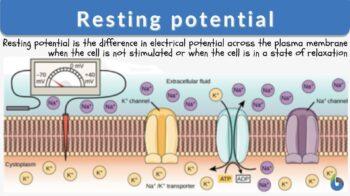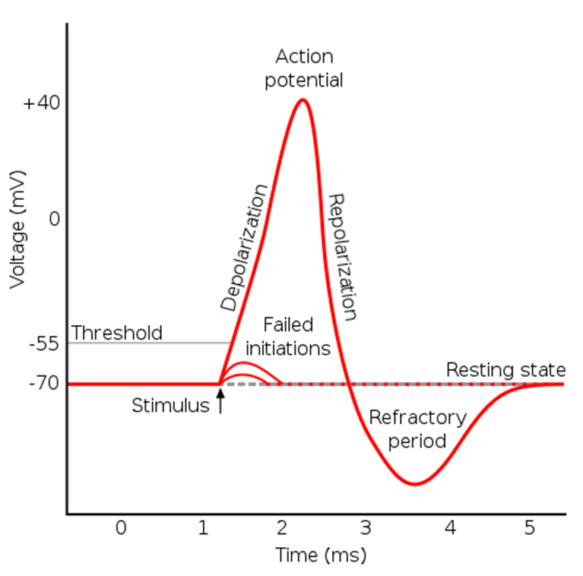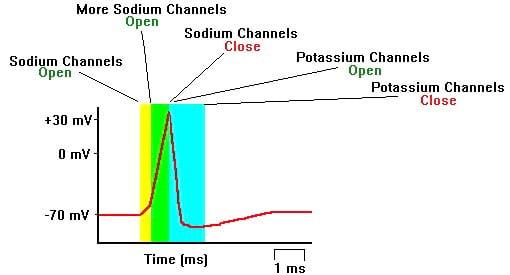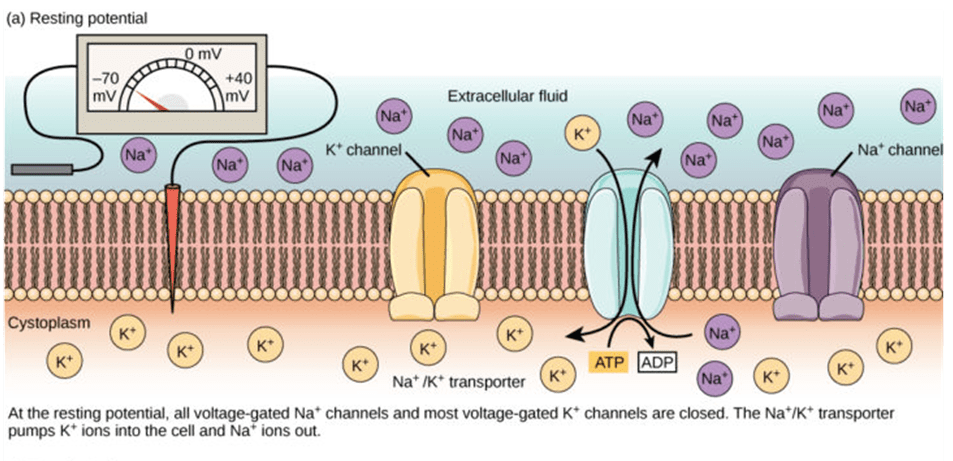
Resting potential
n., plural: resting potentials
[ˈrɛstɪŋ po(ʊ)ˈtɛnʃəl]
Definition: The electrical potential of the inside of a cell, relative to its surroundings
Table of Contents
Resting Potential Definition
The resting potential of a cell is defined as the difference in electrical potential across the plasma membrane when the cell is not stimulated or when the cell is in a state of relaxation. Differences between a cell’s internal and external electrical potential have traditionally been expressed as a percentage difference.
The resting potential is the amount of power that is available to a cell to maintain its homeostatic state. It is usually measured in terms of the power of a neuron, which is the smallest amount of electrical charge that can be produced by a neuron. As long as the cell is maintained at rest, it can continue to be self-sustaining. If the cell fails to maintain homeostasis, it will eventually die.
In biology, the resting potential is the potential that will sustain a neuron in an active state. The resting potential can be defined as the potential below the threshold of neuronal activity (Chrysafides, Bordes, & Sharma, 2019).
Resting potential (definition in neuron psychology): When a neuron is at rest, its sodium channels close. The resting potential of a neuron is typically in the limit of –50 to –100 mV for vertebrate neurons. This shows the surplus negative charged ions on the inner side of the membrane. Unlike other cell types, neurons and muscle cells are capable of transitioning from a resting state to a more active one. (Association, 2022)
Frequently Asked Questions
Let’s take a look at the common frequently asked questions about resting potential:
What is resting potential?
A resting potential or simply the resting membrane potential (RMP) is defined as a resting neuron that has positive voltage all over the membrane. The concentration gradient of ions across the membrane is used to determine the resting potential. The penetrability of the membrane to different types of ions.
K+ and Na+ concentration gradient available over the entire membrane in resting neuron. Ions descend their gradients via channels, which causes the charges separation and it leads to the creation of the resting potential.
Relatively static membrane potential is considered the basic value of transmembrane voltage. The resting voltage or resting membrane potential (RMP) of a quiescent cell (irreversible state of the cell) is also known as the relative static membrane potential. It is opposite to the dynamics electrochemical process which is referred to as graded membrane potential and action potential. (Acedemy, 2022)
How about graded potential? What is a graded potential?
The alterations in membrane potential are known as graded potentials. They show variation in their size.
What is normal resting membrane potential?
The characteristics of resting membrane potential are not only limited to neurons but it is also a feature of almost all animal cells. Its value ranges from approximately -5 millivolts (in erythrocytes) to -95 millivolts (in skeletal muscle). The resting membrane potential of a neuron is usually -65 millivolts. The interior of the cell has a more negative charge as compared to the exterior of the cell. (Rudolph, 2015)
The concentrations of which two ions are highest outside the cell?
Typically, a higher level of potassium ion K+ is present inside the cell. At the exterior of the cell, the level of Sodium and Chloride ions (Na+ and Cl-) are in higher concentration. (Acedemy, 2022)
State the resting potential of the mouse hippocampal pyramidal neuron:
The estimated RMP of CA3 hippocampal pyramidal cells is –84 ± 3 mV. (Tyzio et al., 2003)
The resting potential is the “potential” of a cell “at rest“. Potential, in this sense, refers to the “electric potential”. Electric potential is the imbalance of electric charges, such as that occurring in the plasma membrane of an electrically excitable cell. The interior and the exterior of the plasma membrane may generate an electric potential as a result of the differences in the energy required for electrically-charged molecules (ions) to move across the membrane. An example of an electrically excitable cell is a neuron. When at rest, the neuron is negatively charged relative to its environment. This is because of the following events:
- At rest, the negatively charged ion, Cl– and the positively charged ion, Na+, cannot easily cross the plasma membrane of the neuron.
- Negatively charged proteins cannot readily leave the neuron as well.
- A membrane pump moves three Na+ out for every two K+ entering the cell. As a result, more Na+ ions are outside than inside and more K+ ions inside than outside the cell.
This leads to a resting membrane potential of about -70mV, which means the inside of the neuron is about 70 mV less than its environment. But when a stimulus arrives, the sodium channels of the neuron “open” to allow Na+ ions to move passively into the cell. This will make the neuron becomes less negative, i.e., -55 mV, which could further go beyond the threshold until it becomes positive (e.g., 30 mV) — as in the case of an action potential.
History
Observations and descriptions of resting currents in nerves were first published in 1902 by Julius Bernstein, who suggested a “Membrane Theory”. The theory tells us about the resting potential of muscle as well as of neurons as a diffusion potential in a membrane. (Wikipedia, 2022b)
Electroneutrality
The majority of quantitative treatments of membrane potential. Specifically, the case of derivation of the Goldman equation is based on the assumption of electro-neutrality which says that ‘there is no detectable charge surplus available on either side of the membrane’.
Due to different charges, an electric potential difference is available over the membrane. There is no discernible difference in the levels of negative and positive ions on either side of the membrane, which means neither side has an actual measurable charge excess.
The major reason is that influence of charge on electrochemical potential is comparatively large as compared to the effect on the concentration. Therefore, fluctuation in the electric potential is caused by variation in the concentration.
Generation of the Resting Potentials
The membrane potential is ascended when in its resting state because potassium ions K+ are chiefly penetrable to the membrane. As a consequence of neuron depolarization, an action potential starts at the axon hillock. The opening of voltage-gated sodium ion Na+ channels as a result of an electrical stimulus during depolarization. Due to the positive charge of Na+, when it re-enters the cell, it changes the potential of the cell from a negative charge to a surplus positive charge.

When a threshold potential is crossed, an action potential is generated. An action potential will only be produced when the threshold is crossed. Additionally, if the threshold is crossed, the same amount of response is always generated, regardless of the stimulus strength. So, the action potentials are defined as “all-or-nothing “.
Voltage-gated sodium ion Na+ channels start to shut when the cell is depolarized. Voltage-gated potassium ion K+ channels are opened by the positive potential inside the cell. K+ ions moved towards the exit of the cell with the help of an electrochemical gradient. When K+ comes out from the cell, the membrane potential shifts towards more negative and begins towards the resting potential.
Typically, repolarization (the restoration of a polarized condition) exceeds the resting cell membrane potential. This results in a membrane potential that is more negative. This phenomenon is referred to as hyperpolarization. It is critical to highlight that the sodium-potassium pump of a neuron (Na+/K+ ATPase) is not engaged in the repolarization process. Immediately after every action potential, there is a refractory phase. This time may be further subdivided into the following categories:
- The absolute refractory time that occurs after the closure of sodium channels after an action potential. Sodium channels then reach an inactive state that is irreversible reopen, nevertheless of the membrane potential.
- The relative refractory time during which channels of sodium ion eventually reactivate. In this time interval, more impulses are required to stimulate the neuron than those which are normally needed to generate the action potential. The stimulus strength needed is quite strong in the early stages of the relative refectory period. It gradually decreases in size over the relative refractory phase as more sodium channels reactivate. (Series, 2022)

Membrane Transport Proteins
Ion transporters and ion channels are the two most essential kinds of membrane ion transport proteins that also determine membrane potentials.
Ion channel proteins establish pathways across cell membranes in a way that allows ions to diffuse impassively without requiring metabolic activity. They exhibit ions selectivity; consequently, chloride, sodium, and potassium selective ion channels exist.
The amount of transport protein in various cells and different parts of the same cells such as cell bodies, Ranvier nodes, and dendrites varies. For regulating the action potential, the level of potassium channels is very essential. The difference in charges across the cell membrane is caused by the sodium-potassium pump neuron (Na+/K+-ATPase), which is electrogenic. It contributes to the membrane potential. For proper functioning, pumps used metabolic energy in the form of Adenosine Tri Phosphate (ATP).
Equilibrium Potentials
For the resting potential in many animal cells potassium ions, K+ is very essential. The level of potassium ion (K+) is more inside as compared to outside due to the active transport. Most of the cells have selective potassium channels. The channels remain open permanently. Through these channels, there is the movement of potassium ion (K+), which result in an excessive negative charge within the cell. Through diffusion, positively charged K+ moves outside the cell. This step is followed until the maximal negative charge increases within the cell, creating a membrane potential capable of balancing the level of potassium within and outside the cell.
Electric potential or force is generated due to the accumulation of ionic charges and it also hinders the process of diffusion. This cycle is continued until it is equivalent in magnitude but opposed in direction to the movement of potassium which diffuses outward. The equilibrium potential for potassium ions is defined as the point at which the entire transmembrane flow of potassium ions is zero. The temperature and level of ion on either side of the membrane are required for creating the equilibrium potential.
Resting Potentials
The resting membrane potential or RMP is not considered an equilibrium potential since it continuously needs energy (through ionic pumps) for restoration. It is a dynamics diffusion potential that is opposite to the equilibrium potential. The system’s ionic species with the highest conductivity across the membrane assist in the dominance of the RMP. As potassium ion K+ has the most negative equilibrium potential among all the other ions, the resting potential cannot be lower than the equilibrium potential of potassium. The voltage equation of the Goldman-Hodgkin-Katz is used to calculate the resting potential. This can be done by using the level of equilibrium potential as well as relative permeability of every ionic species. It is considered that only Chloride, sodium, and potassium ions contribute significantly to the resting potential under typical circumstances.
Measuring Resting Potentials
In some cells such as cells of the cardiac pacemaker, the membrane potential fluctuates continuously. It is a theoretical view that for such a type of cell there is no resting potential or rest. Some other cells have membrane transport potential that fluctuates. The resting membrane potential for such cells can be measured by putting an electrode into the cell. The estimated resting potential of cardiomyocytes is −90 mV.
Additionally, optical measurements of transmembrane potentials may be made using dyes that alter their optical characteristics in response to the potential.

Summary of resting potential values in different types of cells | |
|---|---|
| Cell Kinds | Values |
| Chondrocytes | -8mV |
| Skeletal muscle cells | -95 mV |
| Erythrocytes | -8.4 mV |
| Astroglia | -80 to -90 mV |
| Cochlea | -15 to -40mV |
| Neurons | -60 to -70 mV |
| Photoreceptors | -40 mV |
| Involuntary muscles | -60 mV |
| Smooth muscles of the aorta | -45mV |
Try to answer the quiz below to check what you have learned so far about resting potential.
Further Reading
References
- Acedemy, K. (2022). The membrane potential. Retrieved 01 April, 2022, from https://www.khanacademy.org/science/biology/human-biology/neuron-nervous-system/a/the-membrane-potential
- Association, A. P. (2022). Resting Potential. Retrieved 01 April, 2022, from https://dictionary.apa.org/resting-potential
- Chrysafides, S. M., Bordes, S., & Sharma, S. (2019). Physiology, Resting Potential.
- Rudolph, U. (2015). Diversity and functions of GABA receptors: A tribute to Hanns Möhler, Part B: Academic Press.
- Series, T. M. (2022). The resting membrane potential. Retrieved 01 April, 2022, from https://teachmephysiology.com/nervous-system/synapses/action-potential/
- Tyzio, R., Ivanov, A., Bernard, C., Holmes, G. L., Ben-Ari, Y., & Khazipov, R. (2003). Membrane potential of CA3 hippocampal pyramidal cells during postnatal development. Journal of neurophysiology, 90(5), 2964-2972.
©BiologyOnline.com. Content provided and moderated by Biology Online Editors.





